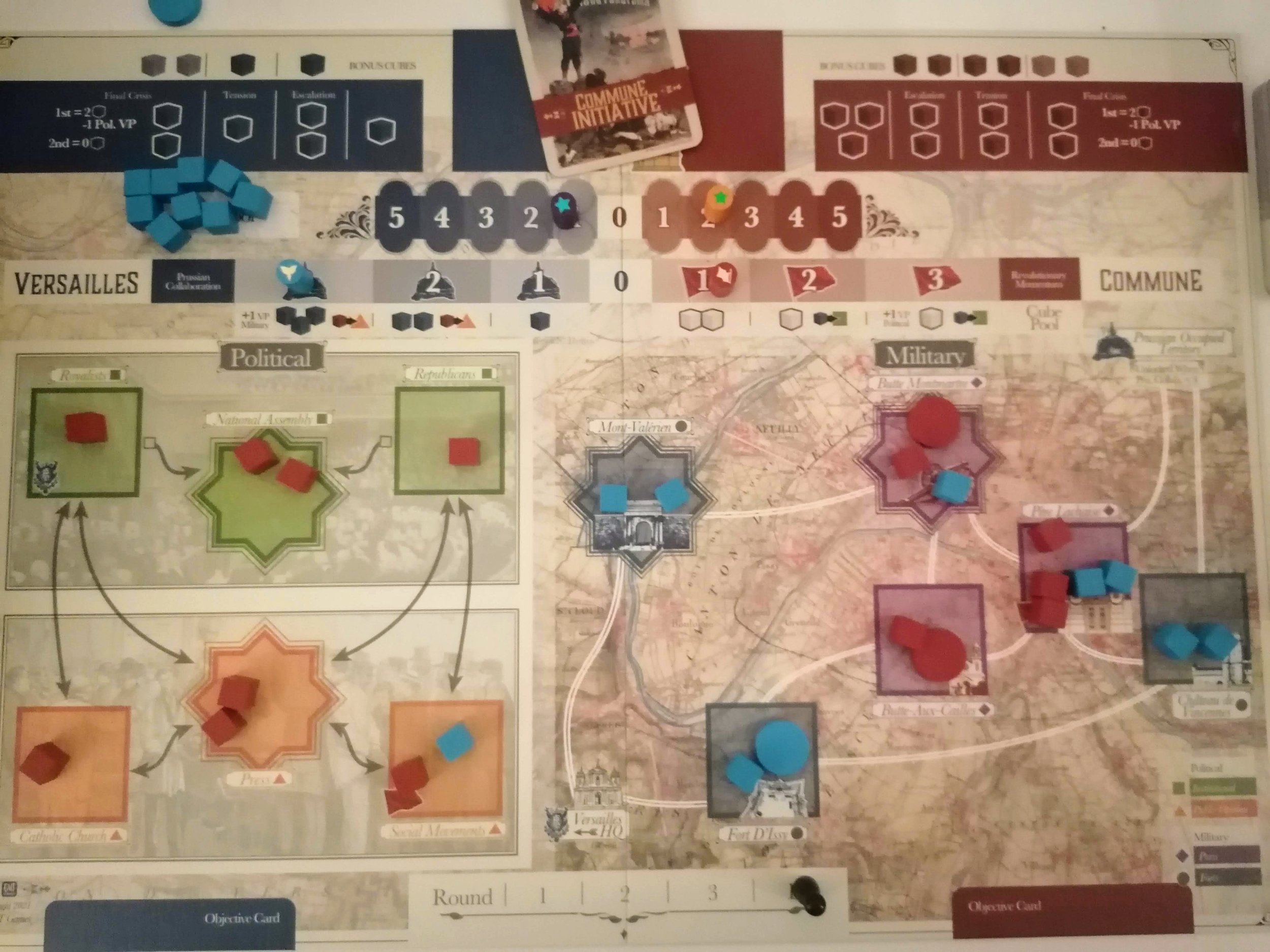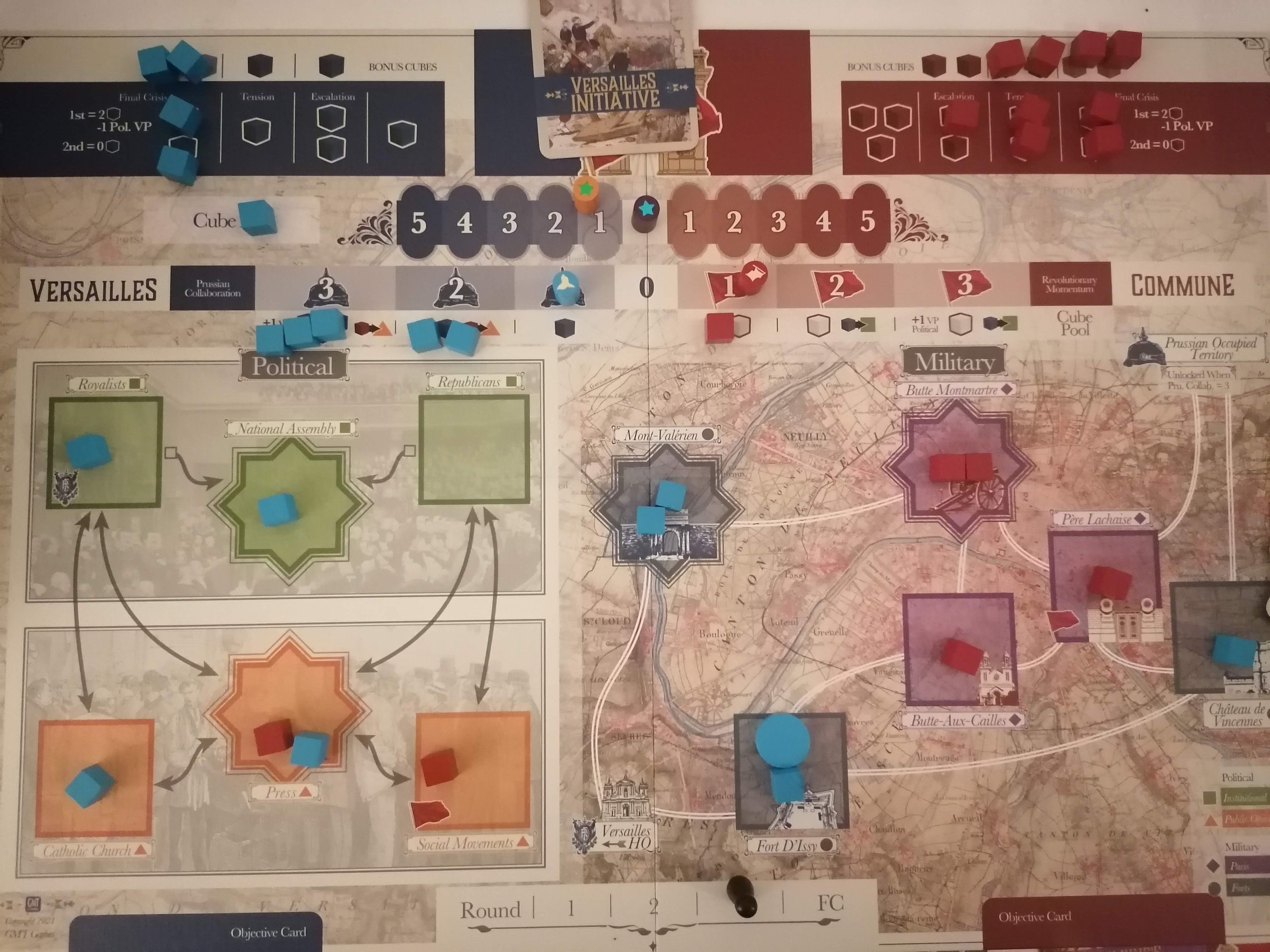I can’t shake the feeling that I’m joining a chorus of wargame commentator by saying that I knew basically nothing about the Paris Commune before playing Red Flag Over Paris, the second game in the Final Crisis Series published by GMT Games. I did actually learn a bit about the Franco-Prussian War in school, but we focused more on Otto Von Bismarck and the theory of Realpolitik and basically ignored anything happening in France. French politics between 1815 and 1914 were not a focus of my teenage education. I must confess that I haven’t taken very many steps to fix that – unless reading The Count of Monte Cristo counts – so I can’t blame my ignorance exclusively on the Virginia public school system. If, like me, you are largely ignorant of this period of history then Red Flag Over Paris may be a great place to start. If you were already a rabid fan of Paris Commune, then I presume you’ve already bought the game and are just wondering if I liked it. The answer is that yes, my initial experiences with it were very positive, read on to find out more!
The game board at set up before anything too chaotic has happened. I don’t think I need to point out that it’s a very pretty board.
As I said, Red Flag Over Paris is the second game in the Final Crisis Series – and really the game that makes it a series at all. The first game was Fort Sumter, designed by Mark Herman and published in 2018. Fort Sumter was about the build up to the American Civil War, ending with the Confederate siege of Fort Sumter in Charleston harbour. The game was a relatively simple card drive game (CDG) where players placed cubes on a mix of mostly abstracted spaces on the board with the goal of controlling a majority of the spaces. Each round players were dealt four cards and played three of them, keeping the last one for the Final Crisis which made up the last round – usually the fourth although there were ways it could trigger earlier. It was a relatively simple game but reasonably enjoyable. I’ve played it a few times thanks to the great little digital implementation on the app designed by Playdek – I bought it for like €2 on my phone and it’s a fun way to pass the time, check it out if the system sounds interesting.
End of Round 1 of my first game - not very much has happened but the Commune are off to a decent start.
Red Flag Over Paris does a lot to add greater depth to Fort Sumter’s core system. In Red Flag Over Paris there are two main types of region to fight over: politics and military. Each of these is then subdivided into two sections, for a total of four areas with three spaces each. Like Fort Sumter there is one pivotal space in each section which gives the controlling player access to special actions before scoring at the end of each round. So far so similar, but Red Flag offers a few significant changes to Fort Sumter’s systems.
The first major change is that there are now rules for adjacency between areas. Fort Sumter’s map was very abstract, and players could place cubes pretty much anywhere unless restricted by a card’s event. Red Flag imposes significant limits on where and how you can place or remove cubes across its two sections – and players can only play in either Politics or Military in a given turn. This adds a lot of complexity to the decision making required for good play without requiring too much new rules overhead. The map helpfully makes it clear which spaces are adjacent to others, and which adjacency paths are only one-way.
End of Round 2, the Commune have seized control of central Paris and are making a push on the National Assembly.
Probably my favourite change is that in Red Flag the cards you keep for the Final Crisis played for their event. In Fort Sumter each card was assigned an area, such as Politics, and in the Final Crisis only this aspect of the card was used to resolve actions unique to that round. In contrast, in Red Flag you have to play the event on the card – and if it is an event that helps your opponent that doesn’t matter. This is both simpler rules wise since you don’t need to learn a whole new set of rules for the Final Crisis phase, and a lot more interesting. Do you want to keep that really useful event for the final round, or should you play it now for an immediate advantage? Scoring happens after every round so keeping it might not be worth it. It also forces you to play cards with your opponents’ events on them, which is important because your opponent can discard a card of matching value to use that event on their turn. There is the potential that you could discard one card in the Final Crisis without playing it, so sometimes you can “bury” a card this way – but if you choose a card you want to bury in the first round you will inevitably come across an even worse card in a subsequent round and wish you’d buried it instead!
End of the game - the scores are low but the Commune manage to squeeze out a victory
Red Flag Over Paris also has a really interesting victory system. Points are zero sum, meaning that if the Versailles player gains a point, they take it from the Commune player and vice versa. There are also two-point tracks – one for the Political and one for the Military sides of the board. The win conditions are slightly asymmetric in such a way as to nudge the Versailles player towards Military points and the Commune player towards Political, but you can’t neglect the other area as victory requires some balance in point totals. I’m kind of a sucker for zero sum points systems in wargames, so this really appealed to me.
Game 2, end of Round 1: Factions have clearly gotten confused as Commune seizes Paris while Versailles focuses on the political.
I also have to confess that I feel a little bad only talking about the mechanics of the game, because I’m so unfamiliar with the theme that I can’t really dig deeper into it. The rise (and eventual fall) of the Paris Commune is a fascinating topic for a game. I really enjoyed that it was set in a time period I vaguely knew something about – I’m at least familiar with the broad strokes of the Franco-Prussian War – but introduced me to something I’d never heard of. I even recognise several of the characters on the cards but had no idea they were even tangentially involved in something like this. It’s a great example of using wargaming to bring an interesting but somewhat obscure moment in history to a wider audience. Also, given Paris’ long history of rioting and rising up against the ruling party it’s about time we got some wargames that depicted it in greater detail. Hopefully Red Flag Over Paris kicks off a trend, and the next big thing is a game about the Jacquerie.
By Round 3 things are looking a lot worse for the Commune - they still hold central Paris but not much else.
So far, I’ve only played Red Flag two handed solitaire, but I enjoyed both of my games even without a real human opponent. It helps that I struggle to remember what cards I had in the other hand when I’m playing as either side so the illusion of a real opponent remains intact. Red Flag comes with solo bots for both the Versailles and Commune players but I’m something of a bot novice and struggled to wrap my head around it the first time I tried using one. In the end I decided that I preferred playing both sides, but I intend to revisit the bots in the future because I’ll be damned if I’m letting a flow chart defeat me. I’m also very much hoping to get a game in with a human opponent in the near future because I think that’s where the game will really shine.
Game 2 ends in a decisive Versailles victory
Red Flag Over Paris is basically the ideal sequel for a series, adding a dose of extra complexity to create an ocean of new depth in the system. I’ve only really dipped a toe into the game and I’m excited to try it more. Each game only uses a small fraction of the available strategy cards, so there’s a lot more to explore – and a lot to the game I haven’t discussed such as how few cubes players have available which constantly stretches your limits in how strongly you can contest regions and how annoying it is when the Versailles player removes your cubes as the Commune player. It’s a really interesting game is what I’m getting at.
I also must note with my humblest apology that at time of writing it looks like Red Flag Over Paris seems to be pretty much completely sold out. My timing leaves a bit to be desired, and I apologise if I’ve piqued your interest in a game you cannot actually play. Hopefully there will be a reprint in the near future. If there isn’t, I think we all know what to do – take to the streets and start building barricades!







